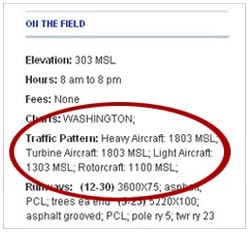| This ePilot Flight Training Edition is sponsored by

Advertisers
                 
Do not reply to this e-mail. Got news? Contact ePilot. Having difficulty using this service? Visit the ePilot Frequently Asked Questions now at AOPA Online or write to [email protected].
Aircraft Owners and Pilots Association
421 Aviation Way
Frederick, MD 21701
Tel: 800/USA-AOPA or
301/695-2000
Copyright © 2007 AOPA. | | Training Tips | | KNOW THE TPA
It's the pivot point for all flying in an airport's vicinity, especially the arrivals and departures reviewed in recent Training Tips. That's why knowing and using the correct traffic pattern altitude (TPA) is vitally important. There are general rules, but many airports require a TPA other than the normal 1,000 feet agl. So no "ballparking" allowed; research the TPA and adhere to it within 100 feet—as required in the Private Pilot Practical Test Standards, Area of Operation III, Task B. "Traffic pattern altitudes can range between 600 and 1,500 feet agl. Some airports that have mixed traffic may have several TPAs—for example, one for light aircraft, another for heavier aircraft, and perhaps a third for helicopters. Chapter 4-3-3 of the Aeronautical Information Manual (AIM) states that 1,000 feet agl is the recommended pattern altitude unless established otherwise. It is the airport management that 'establishes otherwise.' The Airport/Facility Directory (A/FD) lists traffic pattern altitudes that are different from the 1,000-foot general recommendation. So if no TPA is listed for a particular airport, the 1,000-foot  recommendation would apply. However, sometimes airport management decides to set or change a traffic pattern altitude (within the parameters of 600 to 1,500 feet) and the new TPA is not listed in the A/FD," explained this answer to the Final Exam question in the Aug. 29, 2003, AOPA ePilot newsletter. As an example, see this notice of TPA changes at the Venice, Fla., airport. You also can find an airport’s TPA in AOPA’s Airport Directory Online. recommendation would apply. However, sometimes airport management decides to set or change a traffic pattern altitude (within the parameters of 600 to 1,500 feet) and the new TPA is not listed in the A/FD," explained this answer to the Final Exam question in the Aug. 29, 2003, AOPA ePilot newsletter. As an example, see this notice of TPA changes at the Venice, Fla., airport. You also can find an airport’s TPA in AOPA’s Airport Directory Online.
Finding yourself at the wrong altitude when nearing the airport reflects poor descent planning. Alton K. Marsh offers excellent remedies in the February 2003 AOPA Pilot article "Get Down!" including these positional factors to consider: "Tuning in the airport weather information and figuring out the runway in use, as well as knowing the direction of traffic for that runway, also can affect descent planning. For example, do you want to be west of the airport when reaching pattern altitude? East? It is rare that you would want to be overhead, unless you need to see the windsock or just need to locate the field." So don't leave your TPA to guesses or assumptions. Look up the magic number, and then use it.
| | Your Partner in Training | | Pilots can never have enough information about the airports to which they fly. Instrument-rated pilots have long known that U.S. terminal procedures—also known as instrument approach charts—are bountiful sources of such information. You don't have to be instrument rated to use them. For example, an airport diagram is part of every approach chart, and for VFR pilots, it is perhaps the chart's most informative component. AOPA's Airport Directory Online contains current airport approach charts, as well as other important airport information available online only to AOPA members—and it's free! Do you have a question? Call the experienced pilots in AOPA's Pilot Information Center at 800/USA-AOPA. They're available to take your calls weekdays 8:30 a.m. to 6 p.m. Eastern. As an AOPA Flight Training Member, you have access to all of the features within AOPA Online and AOPA Flight Training Online. Login information is available online.
| | Flight Training News | | GA SECURITY: ONLINE COURSE TEACHES YOU HOW TO DO YOUR PART
General aviation security is one of AOPA's top priorities. To ensure pilots, flight schools, airport tenants, and businesses do their part to secure their aircraft and airports, AOPA teamed with the Transportation Security Administration to develop the new online course, General Aviation Security . As a student pilot or flight instructor, you can help protect your access to GA by voluntarily adopting simple security practices outlined in the course. "It's imperative that we as a GA community do our part to secure our aircraft, our airports, and in effect our future," said AOPA President Phil Boyer. Read more on AOPA Online. MOTHER, SON SOLO ON SAME DAY
Completing your first solo flight is a special memory, especially if you solo on the same day as your mother, like Steve Poteet of Fort Worth, Texas. "It really is an awesome thing to share with her," said Poteet, 43. He watched his 64-year-old mother, Sylvia, solo on Nov. 29 at Seymour Municipal in Seymour, Texas, where she resides. "Then we hugged, high-fived, and I got in and did mine," he added. About a month before the big day, the Poteets came to the realization that they were at about the same place in terms of their skill levels, and that it might be possible to solo at the same place on the same day, he said. Their flight instructor agreed they were both ready. Read more on AOPA Online. CONGRESS HONORS YOUNG PILOT FOR ROUND-THE-WORLD FLIGHT
Congress honored AOPA member Barrington Irving with a resolution (House Resolution 661) earlier in December, marking his achievement as the youngest pilot and first African American to fly solo around the world. From March 23 to June 27, 2007, the 23-year-old pilot flew 24,600 miles around the globe in a Columbia 400 dubbed Inspiration. In its resolution, Congress encouraged aviation-related museums around the country to commemorate Irving's feat. Read more on AOPA Online. NEW YEAR'S RESOLUTION: BECOME A SAFER PILOT
With the new year just a few days away, why not resolve to sharpen your flying skills and become a safer pilot in 2008? With the broad array of resources available from the AOPA Air Safety Foundation, this is one resolution you can easily keep. Start with the foundation's growing selection of interactive online courses. Free and easy to use, these engaging, self-paced courses take about an hour to complete. Most qualify for FAA Wings credit. Resolve to complete at least one course each month in the year ahead, and every flight you take in 2008 will be a safer one. MICHELIN AIRCRAFT TIRE OFFERS AVIATION SCHOLARSHIP
Michelin Aircraft Tire is partnering with Careers in Aviation to offer a $1,000 scholarship to a qualified applicant to complete an aerospace education. The scholarship is open to students enrolled in an aviation-related degree program with a grade-point average of 3.0 or higher. The deadline to apply is Aug. 30, 2008, and the scholarship will be awarded in fall 2008. For more information and a scholarship application, see the Web site.
| | Inside AOPA | | AOPA BRINGS GA TO POPULAR WEB SITES
To create excitement and interest in flying, AOPA is targeting young people and the places they hang out on the Web like YouTube, MySpace, and FaceBook. Site visitors can see videos of young people talking about their favorite flying experiences and sharing advice about getting started. Videos are already posted on YouTube, so take a look and share them with your friends. SAFETY QUIZ HIGHLIGHTS 2007 'NALL REPORT'
The AOPA Air Safety Foundation's Joseph T. Nall Report analyzes yearly accident trends in general aviation, thereby providing you with a valuable safety tool. By examining the types of accidents other pilots experience, you can assess where you need to focus your training to become a safer pilot. Test your knowledge of the types of aircraft included in the 2007 Nall Report , the largest contributors to accidents and incidents, and the phrases of flight in which accidents are most likely to occur in this Safety Quiz. HAVE YOU UPDATED YOUR AOPA MEMBER PROFILE?
To make the most of your membership and allow us to serve you better, please visit AOPA Online and update your personal member profile.
| | Training Products | | SKY HIGH GEAR INTRODUCES SMALLER FLIGHT BAG
Sometimes you don't need a large, bulky flight bag to tote your flying essentials—for a trip around the pattern, or for a CFI in the right seat who needs to carry the basics. If a smaller bag would be more suitable for your mission, consider the Sky High Gear Freedom VII flight bag, available from ClassicJet.com. Constructed of ballistic nylon, the bag is 13.5 by 9.5 by 5.5 inches and comes in a choice of color accents. It sells for $34. Order the bag online. Note: Products listed have not been evaluated by ePilot editors unless otherwise noted. AOPA assumes no responsibility for products or services listed or for claims or actions by manufacturers or vendors.
| | Final Exam | | Question: Is there an FAA regulation that says a pilot must be able to reach all required flight controls? Answer: There isn't a direct regulation to address this; however, FAR 91.105, "Flight crewmembers at stations," states that crewmembers be at their pilot stations during the takeoff, landing, and en route stages of a flight in order to perform their necessary duties. Pilots who need pillows or cushions to elevate themselves in order to see over the panel should exercise common sense in order to safely operate the aircraft. The AOPA Flight Training article, CFI to CFI: Physically challenged students, discusses the issue of being physically challenged within the cockpit environment. Got a question for our technical services staff? E-mail to [email protected] or call the Pilot Information Center, 800/872-2672. Don't forget the online archive of "Final Exam" questions and answers, searchable by keyword or topic.
| | Picture Perfect | Looking for some really fabulous aviation photography? All the air-to-air photos and beautifully detailed ground images used by AOPA Pilot magazine over the years are yours at the click of a mouse button. Download your favorite images to use for wallpaper, send an e-postcard, or order prints online. For more details, see AOPA Online.
| | Weekend Weather | See the current weather on AOPA Online, provided by Jeppesen.
| | ePilot Calendar | UPCOMING FLYING DESTINATIONS:
There are no national events this week. To submit an event to the calendar or to search all events visit AOPA Online. For airport details, including FBO fuel prices, see AOPA's Airport Directory Online. FLIGHT INSTRUCTOR REFRESHER CLINICS
The next AOPA Air Safety Foundation Flight Instructor Refresher Clinics are scheduled in Detroit, and San Antonio, Jan. 5 and 6. Clinics are also scheduled in Long Beach, Calif.; Portland, Ore.; and Sevierville, Tenn.; Jan. 12 and 13. For a complete schedule, see AOPA Online. Can't make it in person? Sign up for the CFI Refresher Online. AOPA AIR SAFETY FOUNDATION SAFETY SEMINARS
AOPA Air Safety Foundation Safety Seminars are scheduled in Reno, Nev., Jan. 7; Sacramento, Calif., Jan. 8; Milpitas, Calif., Jan. 9; and Rohnert Park, Calif., January 10. The topic is "Top 5 Mistakes Pilots Make." For details and a complete schedule, see AOPA Online.
| |





















 recommendation would apply. However, sometimes airport management decides to set or change a traffic pattern altitude (within the parameters of 600 to 1,500 feet) and the new TPA is not listed in the A/FD," explained this answer to the Final Exam question in the Aug. 29, 2003,
recommendation would apply. However, sometimes airport management decides to set or change a traffic pattern altitude (within the parameters of 600 to 1,500 feet) and the new TPA is not listed in the A/FD," explained this answer to the Final Exam question in the Aug. 29, 2003, 
